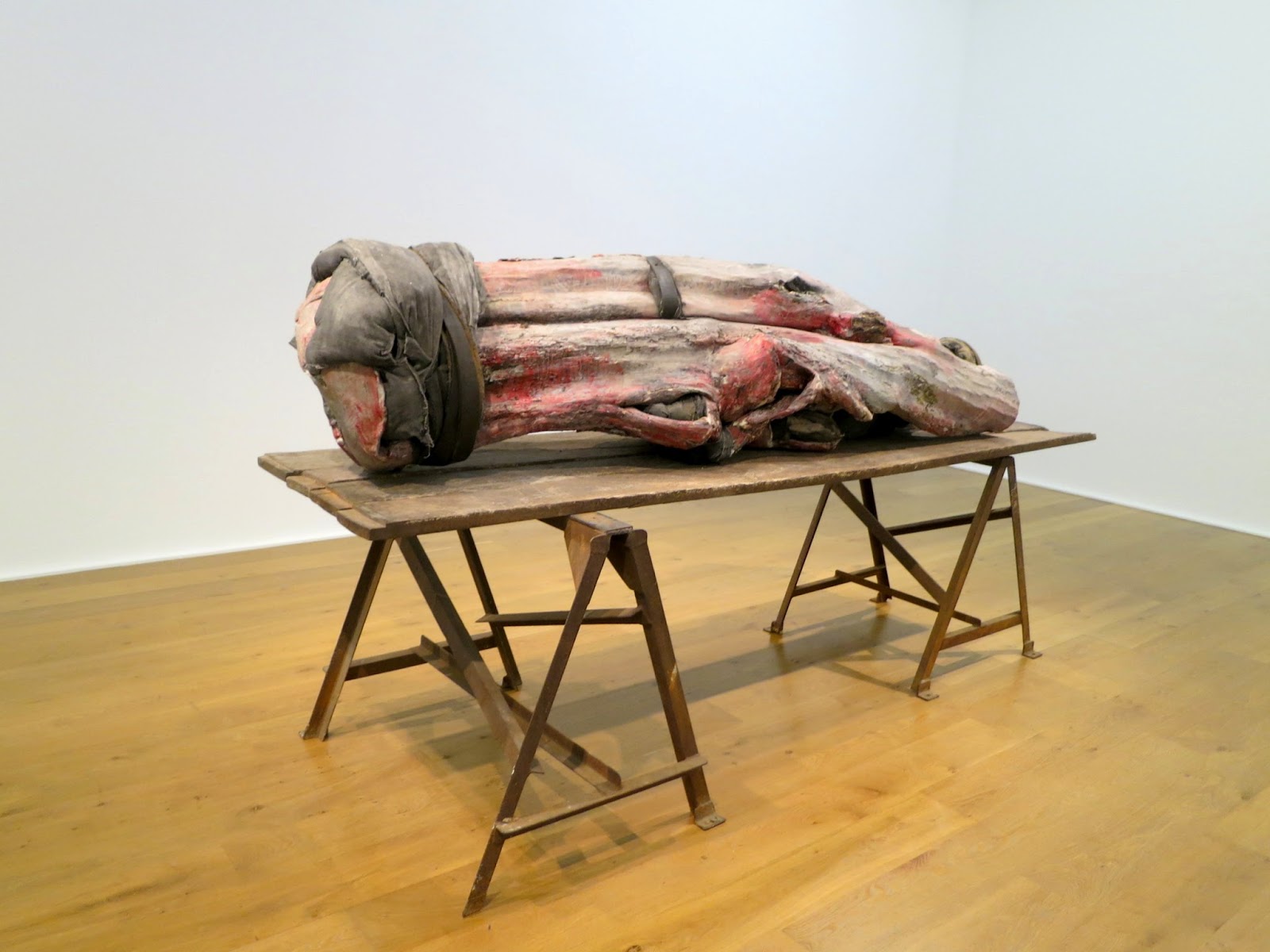Met Tere Huid (Of Tender Skin), by Berlinde De Bruyckere, Hauser and Wirth, Saville Row.
We stumbled upon this exhibition by chance. We went to Hauser and Wirth intending to see the other exhibition that was on, Worry Will Vanish by Pipilotti Rist (post to follow) but as we were there, we thought we'd pop in the South Gallery as well. I am so glad we did. De Bruyckere's work is a revelation and she's an artist that I want to find out more about. I was awed by the texture of the work, its resemblance to human flesh, and the thinking, the conception behind it.
I did some research when I got home, and one of the things I found out is that she has cooperated with J.M. Coetzee and they have produced a book together, which, needless to say, I intend to get. What he has to say about her work echoes my own feelings:
'I have long admired the work of Berlinde De Bruyckere. More, importantly, I have been touched by her work in ways that are often obscure to me. I would not wish it otherwise. Her sculptures explore life and death - death in life, life in death, life before life, death before death - in the most intimate and most disturbing way. They bring illumination, but the illumination is as dark as it is profound'.
Her forms are made of wax, leather, rope and resin and they evoke decay, but it's active decay. They are reminiscent of flesh, but it's flesh at its most active in the process of decay: writhing, rotting, a hub of activity. Paradoxically, they also reminded me of the flaccid folds of Jenny Saville's nudes (which you can see here ).
In their stillness, De Bruyckere's works confront the connection between mortality and life.
After Cripplewood, IV, 2014 (wax, iron, cloth, blankets, ropes, epoxy)
An enormous wax installation of a fallen tree trunk with branches that are twisted round it. Looking closer at the form, it resembles the muscles, tendons and bones of the human form. De Bruyckere has used exactly the same colour that she uses in her human-like figures (which you can see here ), giving the tree parts the appearance of human flesh. She has wrapped pieces of fabric around the knobs and ends of many of the branches, like bandages on broken limbs.
In an interview she explained how she had brought an elm tree that had been destroyed by a storm to her studio and began making wax casts of it. 'I was touched by its having been uprooted', she said. 'People who are uprooted, you never can really place them again. It's much more violent than cutting a tree down. Uprootedness gives a feeling of loneliness'.
A different view
looking closer
Met Tere Huid, 2014 (watercolour, pencil and collage on paper)
A series of drawings that are connected to the sculptures.
After Cripplewood, 2014 (watercolour and pencil on paper)
After Cripplewood, 2014, (watercolour and pencil on paper)
After Cripplewood I, 2013-14, (wax, cloth, wood, iron, polyester, epoxy)
Another abstraction of a fallen treetrunk, bound together with tattered fabric which is again subtly pigmented using a palette that subtly resembles human flesh. The anthropomorphic waxy forms appear as rheumatoid joints and bone, bandaged as if undergoing a prolonged healing process. The work rests on a makeshift trestle that recalls a medical stretcher. In contrast to the bare wooden planks forming the trestle, the gnarled and calcified mass on top appears living, though momentarily silenced.
looking closer
Met Tere Huid I, 2014 (wax, cloth, rope, leather, wood, iron, epoxy)
looking closer
Glassdome with Cripplewood III, 2014 (watercolour, wood, glass, cloth, epoxy, iron)
Finally, a photograph of the artist working on Cripplewood. (Image taken from here )
















Thank you so much for the introduction to this amazing work. Wow, it looks powerful even in photographs. It looks as affecting as the Kiefer - and you are right, I do love research. You have certainly set me off here - although I cannot start immediately, I shall be itching and twitching to get going. Marvellous, marvellous stuff!
ReplyDeleteI felt that too, Olga, that it's as affecting as the Kiefer, and like the Kiefer, photographs don't do it justice. And I wanted to touch, I had this overwhelming need to see what it felt like. I even asked the attendant even though I knew the answer. He of course, said no, but that he could really sympathise with my wish. I also feel like Coetzee in that her work moves me in ways that are obscure to me: I can articulate some of it, but there's lots more there that I just can't put into words. Great art.
DeleteI think that does make the greatest art: that which moves us beyond our describing, beyond our own current comprehension.
ReplyDeleteVery true.
Delete